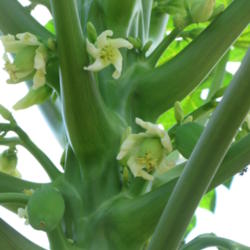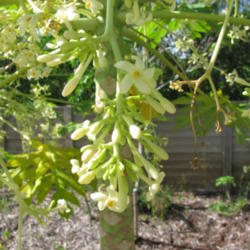Thank you guys. I asked about hermaphrodites because I had never heard the term used for papayas...now I understand.
Hermaphrodites have the "complete" flowers...they self-pollinate. Female papaya plants need pollen from a male or hermaphrodite flower to have fruit. This site shows the differences via pictures:
http://www.ctahr.hawaii.edu/oc...
We have been growing papaya trees for many years, and whenever a male should show up we cut it down since these do not produce fruit. And because we grow several trees at a time the chances of getting hermaphrodites is good. (Learned something new.)
Two years ago we planted 10 seedlings (Red Lady) we bought from Dept. of Agriculture. Nine were planted in close proximity of each other...the 10th was planted nearly 200 feet away. When they started blooming only the 9 planted together produced fruit, the 10th one didn't produce fruit until we hand-pollinated from flowers of the former. Obviously the 10th was a female.
We have several young papaya trees that are starting to produce fruit. The largest one I am fairly certain is a hermaphrodite...there are clusters of small flowers in the axils of the leaves. Come daylight (couple of hours from now), I'll take and post pictures of the flowers and fruits.

